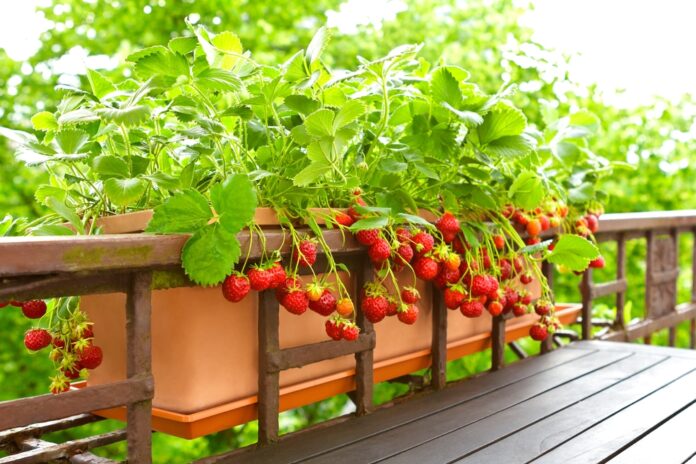Growing your own fruit is a rewarding endeavor, but many people believe it’s only possible if you have a large garden or orchard. The good news is that with container gardening, you can cultivate fruit trees even in the smallest of spaces. Whether you have a balcony, patio, or simply prefer the flexibility of movable plants, this guide will walk you through the essentials of growing fruits in containers.
Why Grow Fruit in Containers?
Container gardening offers numerous benefits, especially for those with limited space or who expect to move in the future. It allows you to:
- Maximize Small Spaces: Even a balcony or windowsill can accommodate a fruit tree in a pot.
- Control Growing Conditions: Easily adjust sunlight exposure and protect plants from extreme weather.
- Portability: Move plants as needed for optimal growth or relocation purposes.
- Extend Growing Seasons: Move containers indoors or to sheltered areas during colder months.
Choosing the Right Fruit Trees
When selecting fruit trees for container gardening, it’s crucial to consider the tree’s mature size and root system.
Opt for Dwarf or Super Dwarf Varieties
Dwarf and super dwarf trees are ideal for containers as they reach a manageable size of 1.5 to 3 meters, making harvesting easier and keeping the tree compact. Some suitable varieties include:
- Trixzie Nectazee Nectarine
- Trixzie Pixzee Peach
- Trixzie Pear cv. Pyvert
- Dwarf Tahitian Lime
These varieties produce full-sized fruits on smaller trees, perfect for suburban gardens and patios. Remember to read labels carefully to ensure you’re choosing the right size for container growth.
Selecting the Perfect Container
The container you choose plays a significant role in the health and success of your fruit tree.
Size and Material
- Size: Use a large container, at least 50 cm in diameter and height, to provide ample space for root growth.
- Material: Options include plastic (lightweight and affordable), ceramic (aesthetically pleasing), and wooden barrels (good insulation). Consider the weight and whether you’ll need to move the container.
Drainage Is Key
Proper drainage prevents waterlogging, which can lead to root rot.
- Drainage Holes: Ensure your container has adequate holes at the bottom.
- Elevate the Pot: Using pot feet or stands can prevent staining on surfaces and improve airflow.
Planting Your Fruit Tree
Step-by-Step Guide
- Prepare the Container: Place a layer of gravel at the bottom to aid drainage.
- Add Potting Mix: Use a high-quality, fruit-specific potting mix, such as Osmocote Citrus Fruit Premium Potting Mix, which provides essential nutrients.
- Plant the Tree: Position the tree in the center, filling around it with potting mix. Ensure the root collar is at soil level.
- Water Thoroughly: After planting, water the tree deeply to settle the soil and eliminate air pockets.
- Mulch: Apply a layer of mulch on top to retain moisture and regulate soil temperature.
Caring for Your Container Fruit Tree
Watering
- Consistency Is Crucial: Container plants dry out faster than those in the ground. Check soil moisture regularly and water when the top 2-3 cm feel dry.
- Self-Watering Containers: For busy gardeners or hot climates, self-watering containers can maintain consistent moisture levels.
Fertilizing
- Regular Feeding: Use a liquid fertilizer like Seasol during the growing season.
- Organic Options: Incorporate organic fertilizers such as Osmocote Plus Organics to promote healthy growth.
Pruning
- Maintain Size and Shape: Regular pruning keeps the tree manageable and encourages fruit production.
- Root Pruning: Every few years, or when the tree becomes root-bound, gently prune the roots and refresh the potting mix.
Dealing with Pests and Diseases
Protecting your fruit tree from pests is essential for a healthy harvest.
- Physical Barriers: Use netting or tree guards to prevent fruit theft by wildlife.
- Regular Inspection: Check for signs of pests or diseases and address them promptly with appropriate treatments.
Seasonal Considerations
Winter Protection
- Move to Sheltered Areas: If possible, relocate containers to protect from frost.
- Insulation: Wrap pots with insulating material or use pot feet to elevate them off cold ground.
Local Advice
- Consult Nurseries: Local nurseries can provide specific recommendations for overwintering and pest control based on your region’s climate.
Tips for Success
- Start in the Right Location: Position your container where the tree will receive ample sunlight—usually 6-8 hours a day.
- Plan for Growth: Prepare the container in its final location to avoid moving heavy pots later.
- Stay Patient: Fruit trees may take a few years to produce substantial fruit, but the wait is worthwhile.
- Educate Yourself: Engage with gardening communities or resources like Gardenerd for ongoing learning and support.
Conclusion
Growing fruit trees in containers is an accessible and rewarding way to enjoy fresh, homegrown fruits regardless of your living situation. By choosing the right trees, containers, and care strategies, you can create a thriving mini-orchard on your balcony or patio. Embrace the journey of container fruit gardening and savor the fruits of your labor!
Start your container fruit garden today and experience the joy of harvesting your own delicious fruits right at home.


